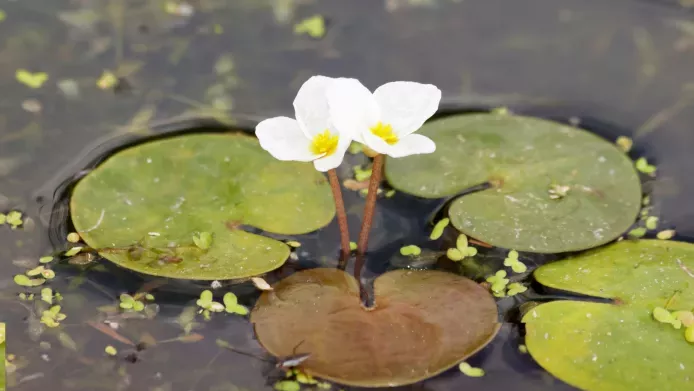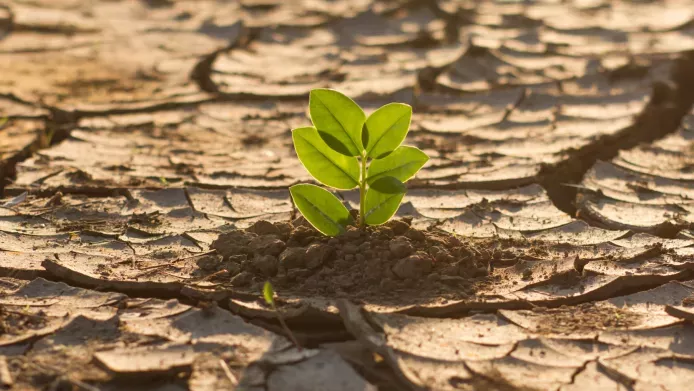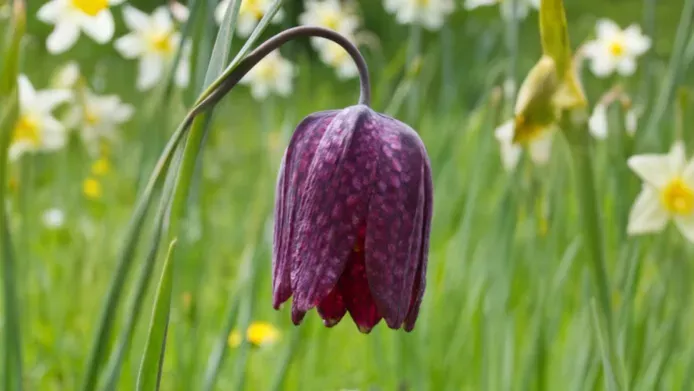UK wetlands are vital for supporting wildlife, providing clean water, food, protection from extreme weather (including floods) and carbon storage.
Even small wetland areas, as well as those in towns and cities, can support a range of unique wildlife including birds, bats, hedgehogs, frogs, newts, dragonflies and other pollinators. Urban ponds and rain gardens provide necessary resources such as food, drinking water, places to reproduce and bathe for passing creatures.
Sadly, freshwater habitats in the UK are declining. According to the Wildfowl and Wetlands Trust, we’ve lost over 50% of our ponds in the last 100 years, with people increasingly turning their gardens and wild spaces into paving or lawns.

Wetland species are in decline
Many wetland plant species are habitat specialists, meaning they have adapted to a limited range of conditions which makes them especially susceptible to habitat changes and pollution.
Many of UK native wetland plants are in decline due to:
- Atmospheric pollution
- Run-off of chemicals from farmland
- Neglect of ponds
- Drainage of wetlands for agricultural use
- Groundwater extraction
- Invasive species
Inspiration for your mini wetland
Here are some of the fantastic ways that projects introduced ponds and aquatic plants to their spaces, as part of Grow Wild's Community Programme:
Wildlife pond - Incredible Edible Garforth saw a significant increase in animal activity following the introduction of a pond to their Community Wildlife area.
Seasonal scrape - Deeper bodies of water may not be possible to include in your space. Love Heaton Norris solved this issue by creating a scrape, which they filled with UK native aquatic and bog plants.
Upcycled container ponds - United to Assist Refugees UK created dig free container ponds by upcycling an unused bath and bidet.
Scroll through the images below to see the projects.
Get creative – there's lots you can do to bring interest and wetland wildlife to your outdoor space.
- Mini pond or small container pond
- Bog garden
- An area of waterlogged soil with slow drainage.
- Drainpipe rain garden
- A shallow area of ground or dip with plants tolerant to waterlogging, which receives rainwater from buildings and other hard surfaces.
- Pond
- Scrape
- A scrape is a shallow pool that holds water seasonally, often drying out in the late summer but remaining damp and boggy, supporting wetland plants and insects.



UK Native plants for your mini-wetland
Whatever the size of your wetland, a mix of the right plants will help keep it clear and oxygenated, preventing algae from taking over. Make sure to add stones and small ledges to your aquatic habitat as it will provide safer access and escapes for any visiting wildlife.
 Frogbit Hydrocharis morsus-ranae
Frogbit Hydrocharis morsus-ranae
Oxygenating plants for ponds
These native plants help keep your pond clear and clean by producing oxygen, absorbing impurities and outcompeting algae.
Despite the misleading name, water violet is a member of the primrose family. It grows in shallow ponds and ditches, with white or pink flowers above the water's surface from May to June.
This plant is native to England and Wales but has declined due to habitat loss and poor management. It is also very intolerant of water pollution.
Hottonia palustris is classed as Vulnerable on the Great Britain Red List.
Greater bladderwort is nothing to turn heads at first, but, like its other bladderwort cousins, is a plant to be feared if you're a small insect... This carnivorous aquatic wildflower has bladder-like organs along the stems which trap passers-by.
It has declined in many areas, mainly due to drainage, destruction of habitats and eutrophication, but it is not of conservation concern.
Eutrophication is the term used for when an excess of nutrients (phosphorous and nitrogen), often run-off from agricultural land, damage freshwater ecosystems by causing plant and algal growth and decreasing oxygen in the water.
It might sound spikey, but Myriophyllum spicatum provides shelter for a range of wildlife. The plant looks like feathery green foliage most of the year until June and July when it grows spikes that poke out of the water with small red flowers on them. These provide a place for dragonflies to lay their eggs.
Also known as coontail or rigid hornwort. While many aquatic wildflowers need low-nutrient water to thrive, hornwort has adapted to grow in nutrient-rich water.
Like many sedges and grasses, greater pond-sedge supports a range of pond invertebrates. It grows in shallow areas of ponds, mostly in the East of England, and flowers from May to June.
Frogbit looks very like a waterlily, with round leaves that float on the surface of the water. It offers shelter to tadpoles, fish and dragonfly larve.
Hydrocharis morsus-ranae is classed as Vulnerable on the Great Britain Red List.
The buttercup-like flowers of water crowfoot provide food for butterflies, bees and other insects. It is a low-maintenance plant quite tolerant of different freshwater habitats including streams and rivers.
Marginal/ bog plants
These plants grow at the edges of ponds and in the damp soil in marshy or boggy environments.
 Water forget-me-not, Myosotis scorpiodes
Water forget-me-not, Myosotis scorpiodes
In late summer you’ll find stars in your pond! This plant is a habitat specialist like scrapes or the shallow areas of ponds which dry out in the summer.
Starfruit needs clean, low nutrient water, and almost declined in the UK before reintroduction in recent years, due to nutrient pollution, as well as the effects of habitat loss and competition from the invasive species Crassula helmsii.
Damasonium alisma is classed as Critically Endangered on the Great Britain Red List.
 Marsh marigold, Caltha palustris L. © RBG Kew
Marsh marigold, Caltha palustris L. © RBG Kew
Caltha derives from the Greek word for “goblet” and you can see why! This plant’s epic flowers provide early nectar for insects.
 Yellow Flag Iris (Iris pseudacorus)
Yellow Flag Iris (Iris pseudacorus)
A pretty wildfower for the edge of ponds or wetlands, yellow flag iris provides shelter for small aquatic animals and its striking yellow flowers support pollinating insects.
Note: Planting it in a basket to keep it contained will prevent yellow flag iris becoming invasive and taking over your wildlife pond.
Water mint is loved by many insects such as peacock and comma butterflies, as well as by humans - its minty leaves can be used to flavour food and drink.
Meadowsweet is a great choice if you want to attract wildlife. It is the foodplant for the larvae of several moth species including the emperor moth and grey pug, and attractive to a wide range of insects.
It has a strong sweet smell, hence its name, and can be used as flavouring in food and drink. It is also thought to have painkilling properties.
 Purple loosestrife (Lythrum salicaria)
Purple loosestrife (Lythrum salicaria)
Purple loosestrife has bold purple flowers that appear in July and August. It provides nectar for pollinators with long tongues that can reach into the flower, like red-tailed bumblebees and elephant hawk-moths.
Purple loosestrife grows across the UK but is less common in Scotland. It was introduced to North America where it is now considered an invasive species.
One of the prettiest aquatic wildflowers to see from May to July. Newts and tadpoles love water forget-me-not, as do butterflies, hoverflies and bees. It’s a good option even for the edges of container ponds.
Slender club rush grows on the margins of ponds, in bog gardens and in container ponds where it helps to oxygenate the water.
Look out for invasive species
Some of the most invasive plants are aquatic plants which have been accidentally or purposively introduced into standing and running waters. Examples to look out for include:
- New Zealand Pigmyweed (Crassula helmsii)
- Floating Pennywort (Hydrocotyle ranunculoides)
- Parrot’s Feather (Myriophyllum aquaticum)
Discover more about creating ponds for wildlife
Wetlands | The Wildlife Trusts https://www.wildlifetrusts.org/habitats/wetlands
How to build a wildlife pond | WWT https://www.wwt.org.uk/discover-wetlands
How to create a mini-wetland | WWT https://www.wwt.org.uk/wetlandss
How to build a pond | The Wildlife Trusts https://www.wildlifetrusts.org
More on UK native plants



